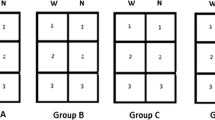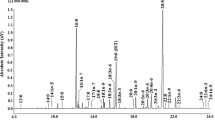Abstract
Algae from cold water (Canada) and warm water (China) were analysed for the total lipid content, and for their fatty acid (FA) composition and content. The major findings are that fatty acids (FA) from Canadian algae are generally richer in polyunsaturated FA (PUFA), with a higher n–3/n–6 FA ratio, and a higher degree of total unsaturation. The C 18:4 FA (stearidonic acid, morotic acid as synonym) was detected in greater amounts in cold water samples. The high levels of total PUFA, and especially of n–3 FA in Canadian algae, suggests possible utilization for nutritional purposes.


Similar content being viewed by others
References
Sardesai VM (1992) Nutritional role of polyunsaturated fatty acids. J Nutr Biochem 3: 154–166.
Zhukova NV, Aizdaicher NA (1995) Fatty acid composition of 15 marine microalgae. Phytochemistry 39: 351–356.
Vaskovsky VE, Khotimchenko SV, Xia B, Hefang, L (1996) Polar lipids and fatty acids of some marine macrophytes from the yellow sea. Phytochemistry 42: 1347–1356.
Dyerberg J, Bang HO, Stoffersen E, Moncada S, Vane J (1978) Eicosapentanoic acid and prevention of thrombosis and atherosclerosis. Lancet 2(8081): 117–119.
Lee T, Hoover RL, Williams JD, Sperling RJ, Ravalese J, Spur BW, et al. (1989) Effect of dietary eicosapentanoic and docohexaenoic acids on in vitro neutrophil and monocyte leukotriene generation and neutrophil function. New Engl J Med 312: 1217– 1224.
Phillipson BE, Rothrock DW, Connor WE, Harris WS, Illingworth DR (1985) Reduction of plasma lipids, lipoproteins, and apoproteins by dietary fish oil in patients with hypertriglyceridemia. New Engl J Med 313: 1210–1214.
Schmidt EB, Kristensen SD, De Caterna R, Illingworth DR (1993) The effects of n–3 fatty acids on plasma lipids and lipoproteins and other cardiovascular risk factors in patients with hyperlipidemia. Atherosclerosis 103: 107–121.
Wu D, Meydani SN, Meydani M, Hayek MG, Huth P, Nicolosi RJ (1996) Immunologic effects of marine- and plant-derived n–3 polyunsaturated fatty acids in nonhuman primates. Am J Clin Nutr 62: 273–280.
Daviglus ML, Stamler J, Orencia AJ, Dyer AR, Liu K, Greenland P, Walsh MK, Morris D, Shekelle RB (1997). Fish consumption and the 30-year risk of fatal myocardial infarction. New Engl J Med 336: 1046–1053.
Singh RB, Niaz MA, Sharma JP, Kumar R, Rastogi V, Moshiri M (1997) Randomized double-blind, placebo-controlled trial of fish oil and mustard oil in patients with supsected acute myocardial infarction: The Indian experiment of infarct survival. Cardiovasc Drug Ther 11: 485–491.
Valagussa F, Franzosi MG, Geraci E, Mininni N, Nicolosi GL, Santini M, Tavazzi L, Vecchio C (1999) Dietary supplementation with n–3 polyunsaturated fatty acids and vitamin E after myocardial infarction: Results of the GISSI-Prevenzione trial. Lancet 354: 447–455.
Von Schacky C, Angerer P, Kothny W, Theisen K, Mudra H (1999) The effect of dietary omega-3 fatty acids on coronary atherosclerosis. A randomized double-blind, placebo-controlled trial. Am Intern Med 130: 554–562.
Harris WS, Lu G, Rambjør GS, Wålen AI, Ontko JA, Cheng Q, Windsor SL (1997) Influence of n–3 fatty acid supplementation on the endogenous activities of plasma lipases. Am J Clin Nutr 66: 254–260.
Leaf A, Kang JX (1996). Prevention of cardiac sudden death by n–3 fatty acids: a review of the evidence. J Intern Med 240: 5–12.
Albert CM, Hennekens CJ, O’Donnell CJ, Ajani UA, Carey VJ, Willett WC, Ruskin JN, Manson JE (1998) Fish consumption and risk of sudden cardiac death. JAMA 279: 3–28.
Guallar E, Aro A, Jiménez FJ, Martin-Moreno JM, Salminen I, van’t Veer P, Kardinaal AFM, Gomez-Aracena J, Martin BC, Kohlmeier L, Kark JD, Mazaev VP, Ringstad J, Guillen J, Riemersma RA, Huttunen JK, Thamm M, Kok FJ (1999) Omega-3 fatty acids in adipose tissue and risk of myocardial infarction: the EURAMIC Study. Atheroscler, Thromb, Vasc Biol 19: 111–1118.
Ficth Haumann B (1998) Alternative sources for n–3 fatty acids. INFORM 9: 1108–1119.
Fleurence J, Gutbier G, Mabeau S, Leray C (1994) Fatty acids from 11 marine macroalgae of the French Brittany coast. J Appl Phycol 6: 527–532.
Carballeira NM, Sostre A, Ballantine DL (1999) The fatty acid composition of tropical marine algae of the genus Halimeda (Chlorophyta). Botanica Marina 42: 383–387.
Kaneniwa M, Kaminishi Y, Kunimoto M (1998) Fatty acid compositions of nineteen species of marine algae mainly obtained from the Yamaguchi Prefecture coast. J Shimonoseki University Fisheries 46: 191–195.
Carvalho A, Malcata FX (2000) Effect of culture media on production of polyunsaturated fatty acids by Pavlova lutheri. Cryptogamie Algologie 21: 59–71.
Sanina NM, Goncharova SN, Kostetsky EY (2004) Fatty acid composition of individual polar lipid classes from marine macrophytes. Phytochemistry 65: 721–750.
Herber SM, Van Elswyck ME (1996) Dietary marine algae promotes efficient deposition of n–3 fatty acids for the production of enriched shell eggs. Poult Sci 75: 1501– 1507.
Folch J, Less M Sloane Stanley, GH (1957) A simple method for the isolation and purification of total lipides from animal tissues. J Biol Chem 226: 497–509.
Rouser G, Kritcheusky G, Yamamoto A, Simon G, Galli C, Bauman AJ (1969). Diethylamminoethyl and triethylamminoethyl cellulose column chromatography procedures for phospholipids, glycolipids and pigments. Methods Enzymol 14: 272– 317.
Galella G, Marangoni F, Risè P, Colombo C, Galli G. Galli C (1993). n–6 and n–3 fatty acid accumulation in thp-1 cell phospholipids. Biochimica et Biophysica Acta 1169: 280–290.
Khotimchenko SV, Vaskovsky VE, Titlyanova TV (2002) Fatty acids of marine algae from the Pacific coast of North California. Botanica Marina 45: 17–22.
Pietra F (2002). Biodiversity and Natural Product Diversity. Tetrahedron Organic Chemistry Series, vol 21, Pergamon Press, Oxford.
Bigogno C, Khozin-Goldberg I, Boussiba S, Vonslack A, Cohen Z (2002) Lipid and fatty acid composition of the green oleaginous alga Parietochloris incisa, the richest plant source of arachidonic acid. Phytochemistry 60: 497–503.
Author information
Authors and Affiliations
Corresponding author
Rights and permissions
About this article
Cite this article
COLOMBO, M.L., RISÈ, P., GIAVARINI, F. et al. Marine Macroalgae as Sources of Polyunsaturated Fatty Acids. Plant Foods Hum Nutr 61, 64–69 (2006). https://doi.org/10.1007/s11130-006-0015-7
Published:
Issue Date:
DOI: https://doi.org/10.1007/s11130-006-0015-7




